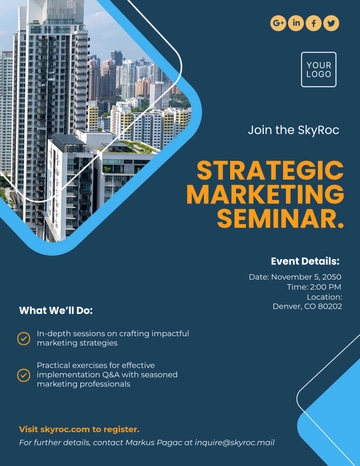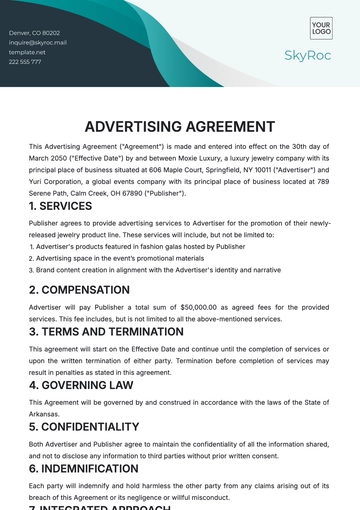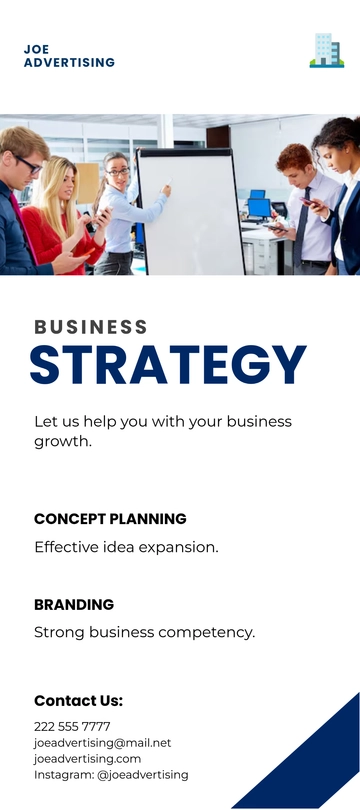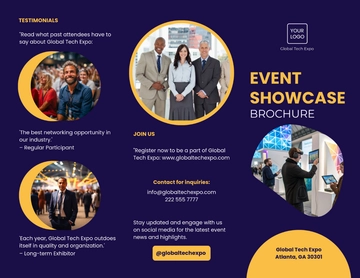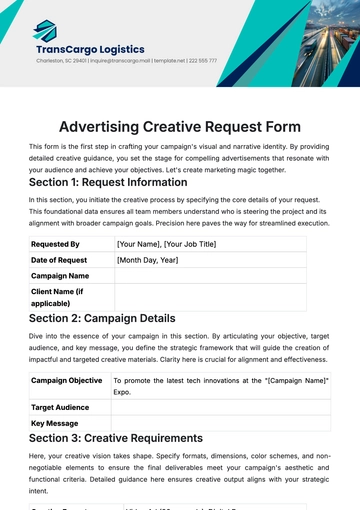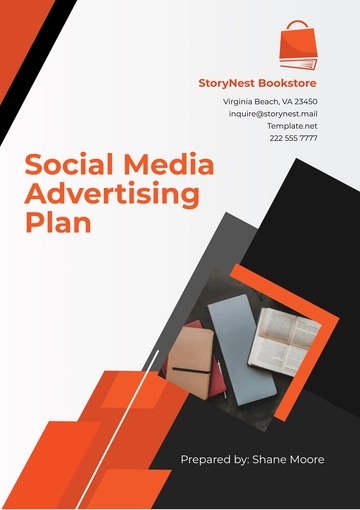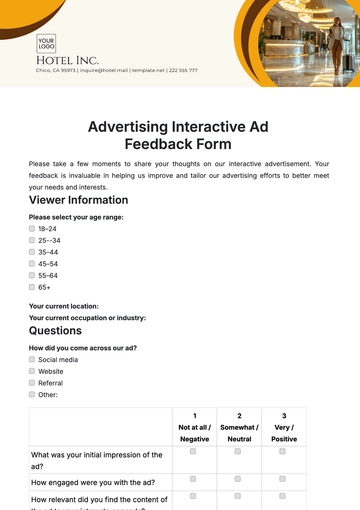Free Advertising Integrated Marketing Campaign

I. Introduction
This document outlines the Integrated Marketing Campaign (IMC) strategy for [Your Company Name], designed to maximize brand presence and drive consumer engagement across multiple channels. The strategy encompasses a holistic approach, leveraging a blend of traditional and digital marketing tactics to achieve cohesive messaging and measurable outcomes.
II. Market Analysis
Understanding the market is critical for tailoring our Integrated Marketing Campaign to resonate effectively with each segment. Here, we provide a detailed examination of our target markets, including demographic insights, behavior patterns, and preferred engagement channels.
A. Market Segmentation
The following table presents the segmentation:
Target Market | Demographic Details | Potential Reach |
Millennials | Ages 24-40 | 3,500,000 |
Generation X | ||
Baby Boomers |
B. Psychographics
Millennials: This demographic is highly environmentally conscious and prefers authenticity, often seeking genuine and transparent communication from brands. Additionally, they are significantly influenced by peer recommendations and social proof, indicating the importance of community and shared values in their decision-making process.
Generation X: This group values loyalty programs and tends to form long-term relationships with brands, showing a preference for brands that acknowledge their loyalty. They are known for their skepticism towards overt advertising and prefer more subtle marketing approaches, emphasizing practicality and value in their purchasing decisions.
Baby Boomers: This demographic is characterized by a strong sense of brand loyalty and a tendency to stick with familiar brands. They also value their connection to local communities and causes, indicating a preference for brands that engage in community-oriented initiatives.
C. Media Consumption Habits
Millennials: Millennials are predominantly engaged with digital platforms, showing a strong preference for mobile devices. They are frequent users of streaming services and social media platforms, particularly those that allow for content creation and sharing. This demographic's high consumption of digital media underscores the importance of mobile-first strategies and content that resonates with their lifestyle and values.
Generation X: Generation X exhibits a balanced consumption of both digital and traditional media. They are equally comfortable with digital platforms, such as social media and email, as well as traditional media like TV and print. This demographic is particularly responsive to nostalgia marketing and personalized email campaigns.
Baby Boomers: Baby Boomers predominantly consume traditional media such as newspapers, TV, and radio but are increasingly adapting to digital trends. While they have a growing presence on social media platforms and online news sources, their digital engagement is more selective, preferring content that is directly relevant to their interests and needs.
D. Market Trends and Predictions
Millennials: Growing interest in sustainable and ethically produced products. Increasing engagement through interactive and augmented reality (AR) based advertising.
Generation X: Seeking more personalized and relevant content. Likely to respond well to nostalgia-based marketing and loyalty programs.
Baby Boomers: Increasing adaptability to technology, with a growing presence on social media platforms. Traditional media remains a strong channel for this demographic.
III. Campaign Objectives
The campaign objectives for [Your Company Name] are designed to be ambitious yet achievable, focusing on measurable outcomes that align with our overall marketing and business goals. Each objective is tied to specific key performance indicators (KPIs) to ensure clear tracking and evaluation of success.
A. Elevated Brand Awareness
The objective is to establish [Your Company Name] as a thought leader in the advertising industry. We aim to achieve this through innovative content strategies and engaging storytelling across multiple platforms. The KPI for this objective will be a combination of social media impressions, brand mentions across various media, and an increase in website traffic. Our target is to achieve [8 million] social media impressions and a [30%] increase in overall website traffic by the end of the campaign.
B. Robust Lead Generation
We intend to not only increase the quantity but also the quality of leads. This will involve enhancing our lead qualification process and employing targeted content marketing to attract potential clients who are more likely to convert. The KPI here will be the number of qualified leads captured, with a target of acquiring [15,000] high-quality leads.
C. Deepened Customer Engagement
Our goal is to foster a stronger connection with our audience, turning casual interactions into meaningful relationships. This involves creating interactive content, leveraging user-generated content, and hosting virtual events to engage with our audience. The KPI for this objective will be the engagement rate across our digital platforms, including likes, shares, comments, and participation in events and surveys. We aim for a [25%] increase in overall engagement rate.
D. Increased Customer Retention
A key objective is to retain existing customers by enhancing their satisfaction and loyalty. We plan to implement personalized marketing approaches, loyalty programs, and regular feedback mechanisms. The KPI for this objective will be the customer retention rate and Net Promoter Score (NPS), with a goal of increasing the retention rate by [20%] and improving the NPS by [10 points].
E. Market Expansion
We aim to penetrate new market segments and geographic locations. This will involve tailored marketing strategies for different regions and segments. The KPI for this objective will be the market share growth in the new segments and the success rate of localized campaigns, targeting a [15%] growth in new market segments.
Each of these objectives are crafted to propel [Your Company Name] towards significant growth and market impact. By carefully monitoring these KPIs, we can adjust our strategies in real-time to ensure optimal performance and achievement of our goals.
IV. Marketing Channels & Budget Allocation
The marketing channels and budget allocation for [Your Company Name] are strategically designed to optimize reach and impact across our target demographics, while ensuring an efficient use of resources:
Channel | Budget | Percentage of Total Budget |
Digital Marketing | $80,000 | 40% |
Email Marketing and Automation | $50,000 | 25% |
Content Marketing & SEO | $40,000 | 20% |
Social Media Advertising | $25,000 | 12.5% |
Print and Traditional Media | $5,000 | 2.5% |
Total | $200,000 | 100% |
A. Digital Marketing
Includes a mix of SEO, content marketing, PPC campaigns, social media marketing, and programmatic advertising.
Objective: To drive brand awareness, lead generation, and customer engagement through targeted online platforms.
Expected ROI: Aim for a [25%] increase in online engagement and a [20%] increase in qualified leads.
B. Email Marketing and Automation
Develop personalized email campaigns, automated drip campaigns, and newsletter subscriptions.
Objective: To nurture leads, increase customer retention, and drive conversion through targeted and personalized communication.
Expected ROI: Target a [30%] increase in email campaign conversion rates.
C. Content Marketing & SEO
Creation of high-quality, SEO-optimized content including blogs, whitepapers, and case studies.
Objective: To establish thought leadership, improve organic search rankings, and drive inbound traffic.
Expected ROI: Aim to increase organic traffic by [25%] and content engagement by [20%].
D. Social Media Advertising
Utilize targeted ads on platforms like LinkedIn, Instagram, and Facebook, tailored to specific audience segments.
Objective: To increase brand visibility and engagement among targeted demographics.
Expected ROI: Target a [30%] increase in social media engagement and a [15%] increase in follower growth.
E. Print and Traditional Media Advertising
Leverage traditional channels such as magazines, newspapers, and local TV spots.
Objective: To reach demographics less active online and reinforce brand presence.
Expected ROI: Aim for a [15%] increase in brand recall and a [10%] increase in inquiries from traditional channels.
This allocation strategy for [Your Company Name] balances the digital and traditional marketing realms, ensuring a diverse and comprehensive reach. The budget is allocated with a focus on digital channels, reflecting modern marketing trends, while still recognizing the value of traditional media in reaching certain demographics.
V. Campaign Timeline
The campaign timeline for [Your Company Name] is meticulously structured to ensure a systematic rollout, effective management, and timely assessment of the integrated marketing campaign. This timeline includes key phases, milestones, and checkpoints for optimal execution and evaluation:
Phase | Start Date | End Date |
Pre-Launch Phase | April 4, 2056 | April 28, 2054 |
Launch Phase | ||
Mid-Campaign Review | ||
Post-Launch Phase | ||
Campaign Closure and Final Analysis | ||
Post-Campaign Follow-up |
A. Pre-Launch Phase
In the crucial pre-launch phase, our focus is on laying a strong foundation for the campaign. This involves conducting thorough market research and finalizing our target audience analysis, ensuring that our strategies are data-driven and audience-centric. Simultaneously, we engage in creative development, where our team conceptualizes and creates compelling campaign assets tailored for different channels. This phase also includes the strategic setup of our chosen marketing channels, both digital and traditional, preparing the groundwork for a seamless campaign launch.
B. Launch Phase
The launch phase marks the official kickoff of our campaign across all platforms. This is a critical period where we closely monitor the initial engagement and feedback across various channels. The insights gathered during this phase are crucial for understanding the immediate impact of our campaign and for making any necessary real-time adjustments to enhance effectiveness.
C. Mid-Campaign Review
We engage in a comprehensive mid-campaign review to assess our performance against the established KPIs and ROI targets. This is a pivotal moment for introspection and optimization. We analyze detailed performance data, enabling us to refine our strategies, tweak creative elements, and adjust our channel focus. This adaptive approach ensures that we remain agile and responsive to the campaign's evolving dynamics.
D. Post-Launch Phase
During the post-launch phase, our focus shifts to maintaining the campaign's momentum. We continue to engage our audience with refreshed content while implementing ongoing optimizations based on the insights gathered. In addition, this phase includes targeted initiatives to deepen our market penetration, focusing on reaching and resonating with more nuanced segments of our target audience.
E. Campaign Closure and Final Analysis
We undertake a comprehensive review of its overall performance. This evaluation encompasses a detailed analysis of how well we met our final ROI and KPIs, providing valuable insights into the campaign's effectiveness. We also focus on gathering feedback, both internally and from our audience, to document key learnings and best practices. This stage is crucial for shaping our future marketing strategies and initiatives.
F. Post-Campaign Follow-up
We initiate customer retention strategies to maintain the engagement and loyalty of the customers acquired during the campaign. Additionally, we monitor the long-term effects of the campaign on our brand awareness, customer loyalty, and overall market positioning. This ongoing analysis helps us understand the enduring influence of our campaign and guides our long-term strategic planning.
This timeline for [Your Company Name]'s integrated marketing campaign is designed to provide a dynamic and responsive approach to marketing efforts. By incorporating regular review points and allowing for strategic adjustments, the campaign is positioned to adapt to market responses and optimize for success continuously. The post-campaign follow-up ensures that the benefits of the campaign are sustained and leveraged for long-term brand growth.
VI. Conclusion
The Integrated Marketing Campaign for [Your Company Name] is a comprehensive approach designed to synergize various marketing efforts across different channels. By leveraging a mix of digital and traditional media, the campaign aims to effectively reach diverse target markets, align with our business objectives, and deliver substantial ROI.
- 100% Customizable, free editor
- Access 1 Million+ Templates, photo’s & graphics
- Download or share as a template
- Click and replace photos, graphics, text, backgrounds
- Resize, crop, AI write & more
- Access advanced editor
Plan your integrated marketing campaigns effectively with our Advertising Integrated Marketing Campaign Template only available here on Template.net! This fully editable and customizable solution ensures you never miss any important detail. The advanced AI Editor Tool makes editing easy, allowing you to create a comprehensive campaign that drives marketing success!
